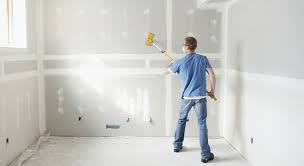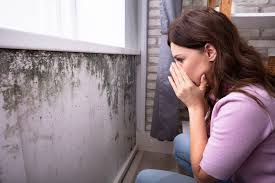Does water damaged drywall need to be replaced?
Water damage is a common reason for drywall replacement in homes. While low cost and versatility make it a very practical interior construction material, resistance to water exposure is not one of drywall’s strong points.
Under certain limited circumstances, drywall can be retained after water damage. In many cases, however, replacement is indicated. The good news is, drywall is not a load-bearing material and can be quickly removed and replaced by qualified professionals without any consequence to the structure of the house. Here are some examples of different possible scenarios:
Minor incidents. Small amounts of water exposure for a brief time—such as splashes from an overflowing appliance or some other temporary incident—are often superficial and are not absorbed into the drywall if dealt with promptly. Wipe the wet portion immediately with absorbent towels, then point a fan at the affected area and run it for an extended period to ensure thorough dryness.
Heavy soaking. If water exposure is substantial due to flooding or other severe incidents that continue for an extended time, the gypsum in drywall inevitably becomes saturated. Typically, the material will deform—sagging, bulging or collapsing. Even if intensive drying techniques are applied, drywall usually does not return to its original shape: After drying, the gypsum core loses its solidity and crumbles easily. In these cases, drywall removal and replacement is a necessary part of professional water damage remediation.
Mold contamination. Drywall affected by water exposure may initially appear intact. However, a delayed consequence may still make replacement necessary. Moisture exposure from any source—acute or chronic—may trigger mold growth on drywall. This typically appears as dark spotting or blotches on the exterior of the wall. Surface decontamination of moldy drywall with effective biocides may eliminate mold growth while it is still superficial. However, once mold has penetrated below the surface into the porous gypsum material, replacement of part or all of the affected panel is usually the most practical recourse.

Why Drywall May Need to Be Replaced After Water Damage
As previously mentioned in the opening segment, interior drywall that has since taken on water damage (which is commonly called “flood damage” and will be used interchangeably throughout this article) needs to be replaced in the majority of cases. Due to the loss of structural integrity of the interior drywall and the potential health risk of developing mold spores.
Few health concerns in your home are as damaging as having mold spores developing inside of your walls. The excess water that had built up inside of your interior wall in most cases do not only damage the drywall. The water soaks into the 2×4 studs, wets any internal wiring, soaks into the insulation which acts like a sponge and seeps into the drywall.
Between all of those interior wall components, you will more often than not develop mold spores of some kind. When that happens the mold will grow, spreading throughout the interior wall, working its way closer to ventilation points in the home. At that point the mold spores become airborne spraying through your home, causing serious issues for anyone who has allergies.
The effects of mold are well known and even healthy individuals who do not have allergies or asthma will be negatively affected as well. It is better to avoid this issue entirely with some simple water cleanup and drywall replacement than to risk airborne mold spores forming inside of the interior walls, only to spread through your home soon after.

Signs Of Water Damage
When drywall gets slightly wet, it can become discolored and stained. This is mostly a cosmetic issue, but if it comes from behind the wall, it should still be remedied as soon as possible. Both the gypsum material and the insulation behind it can hold moisture for a long time, meaning even a small amount of water can turn into mold. You should have both the drywall and the insulation removed before the problem gets worse.
Even small leaks can turn into wider damage. When there’s a leak in the foundation material and moisture remains up against your walls, the walls will start to soak the water up and it will leech through the gypsum. This soaking action is called “wicking”, and the longer the water is left to wick into the drywall, the greater the damage will be.
If the wicking continues to happen, paint or wallpaper on the wall can start bubbling and peeling off. If left to continue, either when a homeowner is unaware or just ignores it, the drywall can begin to crack and crumble, and mold can grow and spread behind the wall. The sagging and buckling can turn the problem into more than just an aesthetic one.

Is Drywall Ruined Once It Is Wet?
Drywall is a common component in modern homes used to create a flat facade between rooms. As its name implies, drywall needs to stay dry as moisture results in warping and rot. If drywall gets wet, replacement is often necessary. Since it is not load-bearing, removing and installing new drywall will not threaten the integrity of your home.
Light Dampening
A splash of water from a glass won’t typically destroy drywall. The same can be true of a small leak if it’s caught soon enough. When this happens, immediately stop the flow of water, and proceed to dry the drywall with towels. Place a fan nearby, and direct the airflow across the affected region. If you’re prompt, you can dry it out before it gets permanently damaged. In the process, it might become discolored, though you can remedy this with white paint. If it begins to sag or warp, you’re better off cutting the affected region from your wall and installing a new sheet of drywall.
Heavy Dampening
If the drywall is exposed to a large amount of water over an extended period, it will become irreparably ruined. A steady leak or flood damage are common examples. Even after it dries, the drywall will not return to its original shape. Instead it will be clearly warped and discolored. Applying firm pressure will cause it to crumble into a dense, chalky powder. Remove the drywall promptly, dry the surroundings and then install a new sheet. Moisture-damaged drywall is not simply an eyesore, but it’s also a health hazard.
Mold
With a little bit of water, drywall can become an ideal environment for mold. Even after drying it out, if mold has taken root, it will persist. In mild cases, the mold will cause discoloration and an unpleasant smell. In extreme cases, such as with black mold, it can negatively affect the health of those nearby. Symptoms include red and irritated eyes, sneezing, headaches and a host of respiratory problems. If drywall shows signs of mold infestation, remove it immediately.
Can Wet Carpet and Drywall Be Rescued?
By taking the right action as soon as possible soaked carpet and drywall (wallboard, sheet rock, plasterboard, or gypsum board) can be saved in many cases. But that’s provided the extraction of excess water and further drying is completed promptly. The amount of water isn’t the key factor in determining if irreparable carpet and drywall damage can be prevented. It’s actually how contaminated the water is and how soon the materials can be completely dried.
Every flooding situation is different, so bringing in expert water damage restorers is the only way to be completely sure of proper damage restoration that keeps everyone safe and minimizes losses. That said, here is some general information that should be helpful.
Deal Killers
Anything that’s come in contact with sewage (Category 3, formerly called black water, such as a sewer or toilet backup) must be replaced, or sterilized by an anti-microbial specialist. The same goes for any type of flooding from a water source that’s been in contact with the ground (also Category 3).
A washing machine or dishwasher overflow, basement seepage, and yard runoff are iffy. You’re dealing with unsanitary water (Category 2) that’s a lower health risk, so careful cleaning and disinfection may be adequate.
If the source was a drinking-water supply pipe, roof, or window leak (Category 1) then you just might be able to keep your carpet and avoid drywall repairs. But that’s only if drying undertaken almost immediately and there’s no mold growth.
Carpet and Rugs
With nearly all wall-to-wall carpets and rugs today made of synthetic fibers the primary problems are mold and bacteria growth. So wet carpet can often be saved if it’s thoroughly dried out before that gets going. The bad news is that you may have as little as 24-48 hours.
For spills and small leaks, blotting by laying down a few towels and walking over them may be enough. You might want to follow that up with a sprinkling of baking soda then vacuuming a bit later.
Dealing with a thorough soaking involves a lot more, as drying from the top surface simply won’t be fast enough. After the extraction of excess water by a wet-vacuum, the carpet should be lifted so it can be dried from both sides using fans to improve air circulation. Carpet padding is cheap and can’t really be cleaned, so you might as well replace it.
With the padding gone you can check the dampness of the concrete or wood sub-floor. If it’s wet you probably need a professional water damage restorer to get everything returned to pre-flood condition. It’s also a good idea to remove baseboards so that they and the drywall behind them can dry faster as well.
It’s generally recommended that to be safe after major incidents you should run fans 24 hours a day for about a week. Depending on conditions, that may also involve sealing the area with plastic and running dehumidifiers. After everything is dry, the padding replaced, and the carpet re-laid the final step is professional carpet cleaning. Steam cleaning is preferred for sanitation, but some carpet fibers may only be shampooed.